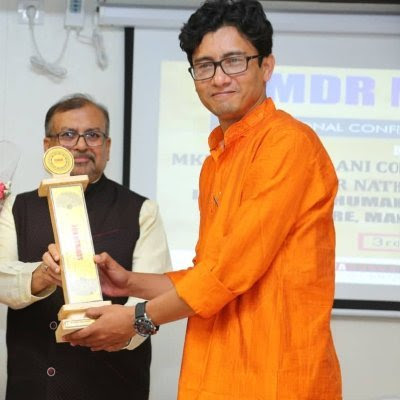Book Review
Red-Rum muR-deR by Sourish Roy
 |
| Red-Rum muR-deR by Sourish Roy |
Author: Sourish Roy
ISBN:
Genre:
Length: 70 Pages
Publication Date:
Publisher:
Rating: 🌟🌟🌟🌟🌟
Order your copy right now: https://amzn.to/3t9RiRl
Recipient of the Best Short Story Collection Award at
Konark Literature Festival 2019 and ICMDR Awards Mumbai 2020 respectively along
with many other medallions of honor and felicitation all across India for his
debut book TALES FROM BENGAL, Sourish Roy, has already earned the renown of
being dedicated to the daily life problems of the underprivileged class. His
stories have been regularly published in English and Bangla dailies and
magazines. His critical essays have also been provided space in some academic
books. Now with Red-Rum muR-deR he looks to embark on a new journey into the
realms of thrill and mystery.
 |
| Sourish Roy |
Facebook: @sourishjal
Instagram: @sourish_roy_author
Twitter: @sourishjal
Summary
Red-Rum
muR-deR by Sourish Roy, primarily, a murder mystery and thriller can also be put
into the subcategory – detective fiction; set in the college campus premises located
at the outskirts of Jalpaiguri, a suburban town in West Bengal, where a
detective-aide duo of college professors embark on the journey of unearthing
the innermost secrets and deciphering the conundrum in order to unravel the murder mystery that hides behind it the grim downside of dissipation and
debauchery; this is a perfect conglomeration of whodunit and howcatchem
bringing about a unique sensation to mystery element; while the book imitates
modern-day classic literature through the author’s flowery language, it also
opens a discussion on the elephant in the room, a subject that is mostly
avoided; this cleverly plotted mystery novella empowered with enticing writing
style, shrewd detective, sensuality, and a compelling riddle will keep you
pondering even after it ends.
Now,
I’ll briefly take you through a few elements of this murder mystery.
Setting:
In any detective fiction, setting plays an important role; the story and its
setting are inseparable elements. Here, the setting can be defined as the
college campus and specifically, the crime scene inside the boys’ hostel. The
story takes place during the Durga Puja—an annual socio-cultural and religious
festival marking the victory of goddess Durga in her battle against the shape-shifting
asura, Mahishasura; popular in and celebrated by Bengalis, Odia, Maithils, and
Assamese communities.
The story also starts with this quick-witted and splendid conversation between two college professors on the subject regarding the splendor of the puja festivities. This sets the tone and the theme right for the upcoming events. Apart from the puja, the story focuses on the squalid condition of the hostel and the disordered room in particular, around which most of the sleuthing occurs. These all elements permit the deadly event and the investigation as well.
Detective-aide
duo: Sourish Roy has done a commendable job at developing these two
complementary characters—Saranya and Sankhajit. Saranya is a highly skilled
problem solver, who possesses traits of being objective, logical, pensive, and
observant. Yes, pretty conventional. Sankhajit is that intellectually inferior
sidekick that most popular detective fiction novels happen to have. Here,
Sankhajit is a narrator for the most part of the story. The dialogues and tones
in the book are compelling and often incorporate allegories, symbolism, and
metaphors, further intensifying the mystery.
Suspects
and the antagonist: The most remarkable part of the book is the subject that
brings together suspects, the victim, and the antagonist. The book, for most of
the part, contains mystery-solving by Saranya, Sankhajit, and the Officer-in-Charge
Dibyendu Lahiri. There is almost everything that you can expect from average
detective fiction when it comes to uncovering the mystery and the duo does a
fabulous job. There are multiple people involved in the act and because the
book is a novella, you come to know ‘who’, ‘why’, and ‘how’ at the very end
during the climax and it’s all done just like that. It is quite impressive how the
author has managed to accommodate such details in the minimal word count. There is
a morally depraved antagonist. There are suspects having more or less the same
virtue as the victim and the antagonist.
Theme:
I would personally prefer Red-Rum muR-deR as detective fiction, having murder
mystery for the central theme. Five out of eight chapters are dedicated to
the quest for the truth. Two out of the remaining three chapters are narrated in
the third-person POV narrating the story in a different timeline that
eventually leads to the crime. This blend of two different styles of writing
detective fiction proves to be crucial for this particular short book. The
pre-eminent subject which the author has deftly tackled is – adultery. I loved
how conveniently it has been established as an inseparable part of the story. In
the end, the author draws a line between being liberated and being promiscuous,
which is a very subjective matter and thus opens an unending debate on the
addressed subject. The author has fitted in literal riddles and incoherently
so, although it only encourages you to interact with the story.
All
in all, this extremely short book, which you can finish reading in the span of
a couple of hours has in store for you a completely unique and a classic
experience emerging through exuberant writing style and the unification of
mystery with sensuality.
Happy Reading!








